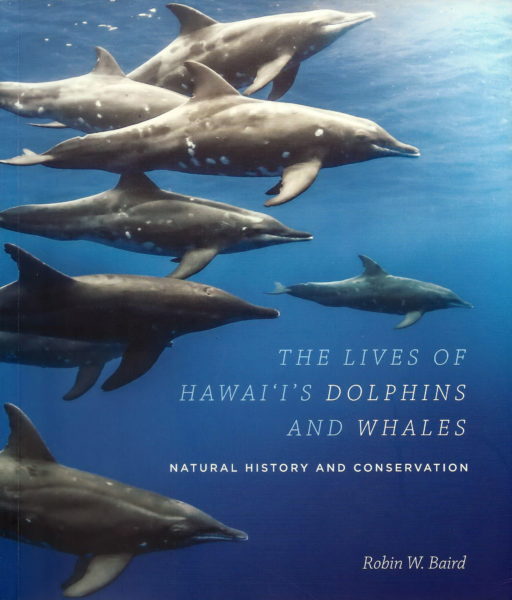Published in the Ocean Watch column, Honolulu Star-Advertiser © Susan Scott
January 7, 2017
Over the years, when I had a question about Hawaii’s whales or dolphins, I would email Robin Baird, a researcher at Cascadia Research Collective. Although this nonprofit scientific and education organization is based in Olympia, Wash., Robin and his team have been traveling here about four times a year since 1999 to study our little-known whales and dolphins.
 The University of Hawaii Press published Robin Baird’s book
The University of Hawaii Press published Robin Baird’s book
“The Lives of Hawaii’s Whales and Dolphins” in November.
Cover photo of resident rough-toothed dolphins by Deron S. Verbeck/iamaquatic.com
Robin always replied quickly to my queries with the latest information and generously offered me the use of photos from the Cascadia website, cascadiaresearch.org (This site has so many out-of-this-world photos and thought-provoking articles that often hours would pass before I wrote one word.)
When Robin and I met for the first time two years ago at Hanauma Bay, we talked about how good it would be to have a book that reported Cascadia’s research and showed off those fantastic pictures.
Now we have one. In November the University of Hawaii Press published “The Lives of Hawaii’s Dolphins and Whales,” by Robin W. Baird.
This is no coffee table book, but the pictures are so amazing I can almost hear the photographers’ whoops of joy when they got many of these shots. There’s the orca carrying a bigeye thresher shark in its mouth, a family of pilot whales carrying, and grieving for, their dead calf, a false killer whale about to bite a mahimahi that was trying to hide behind the photographer — and on and on.
One of my peeves in science writing is that many researchers use jargon and passive verbs to describe what happened: “The diverse time course of the observed subjects …” Not only is this dull reading, but you don’t know who did what to whom. Not Robin. This is marine biology at its finest, detailed science told in everyday language, often in story form.
One of my favorites is the tale, with photo, of a false killer whale offering a researcher a 100-pound ahi (yellowfin tuna). This whale species has the unusual habit of sharing food, not just with each other, but with humans too if they’re nearby.
Another remarkable aspect of “blackfish,” a 17th-century fishermen’s name for five mostly black whale species, is that the females of three — killer, pilot and false killer — stop reproducing when around 40 years old and live 10, 20 or even 50 more years. The theory is that long life after menopause, which as far as we know occurs only in those whales and humans, provides experienced aunties and grandmothers to guide younger generations.
This book is a rare treasure: easy-to-read marine biology with precise science that is also a dazzling picture book. Bravo, Robin.